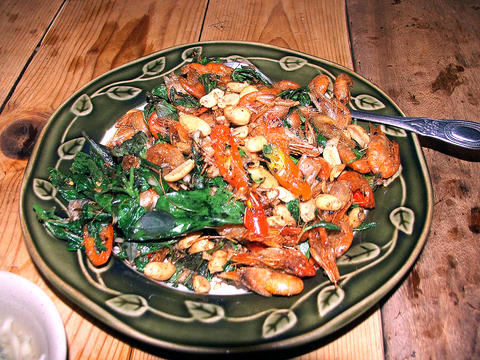Just down the street from the Guting MRT station, across from the Friends Star Hotel (友星大飯店), there's an unassuming little restaurant where democracy activists used to gather for meetings when the country was still under martial law. It's no longer a the scene of political intrigue, but Jinjiang Tea Room, now in its 18th year, is now known as one of the best restaurants serving authentic Hakka dishes this side of Miaoli (苗栗). In the recent food issue of Fountain, a theme-based biannual English-language magazine published by the National Cultural Association (文化總會), the head of the French trade office listed this cozy spot as one of his places to go for Taiwanese food.
Jinjiang goes to great lengths to look like the traditional Hakka rathskeller. Its facade exudes comfort, with deep green and wood varnish trim and windows that give a view of the restaurant's warm yellow walls. Inside, shelves packed full of knickknacks, like an old mechanical clock and jade Buddha, antique wood chairs and long narrow benches, and a table with legs taken from a vintage sewing machine, give Jinjian a comfortably cluttered, rustic feel. There was even a small, Japanese-style room off to one side, an old raincoat and hat made from palm fronds hanging from the wall, and two tables and cushions on the floor. It's the kind of place where you'd expect to get an authentic, home-style meal, and that's exactly we got.
We ordered four dishes: the Hakka salty pork (客家鹹豬肉, NT$200), stir-fried betel nut flowers (炒檳榔花, NT$180), stir-fried river shrimp (炒溪蝦, NT$150) and green tea noodles (綠茶麵線, NT$50). I liked everything except the bin lang flowers, and was especially fond of the green tea noodles and the fatty pork, which was laid out in generous portions on a plate and served with raw scallions and a tangy garlic and vinegar sauce for dipping. My companion, however liked the betel nut flowers, which had a delicate flavor like palm hearts. At the end of the meal we were given complimentary bowls of green bean soup (綠豆湯) and four preserved plums (茶梅).

PHOTO: RON BROWNLOW, TAIPEI TIMES
Other dishes that looked interesting were the Hakka stir-fry (客家小炒, NT$200), made from bean curd, fatty pork, dried squid, red pepper and scallions, and the pork intestines with shredded ginger (薑絲大腸, NT$250). One item I definitely want to try is the lei cha (擂茶), or pounded tea, a mixture of tea leaves, peanuts, mint leaves, sesame seeds, beans and herbs, which are ground into a powder and served as a drink.
My only complaint - and this is a minor one - had to do with the service. Almost immediately after we sat down, the waitress hovered beside our table, just behind me, making us feel pressured, probably unintentionally, to order quickly. When we asked her for recommendations, she responded, "All of our dishes are good."

May 11 to May 18 The original Taichung Railway Station was long thought to have been completely razed. Opening on May 15, 1905, the one-story wooden structure soon outgrew its purpose and was replaced in 1917 by a grandiose, Western-style station. During construction on the third-generation station in 2017, workers discovered the service pit for the original station’s locomotive depot. A year later, a small wooden building on site was determined by historians to be the first stationmaster’s office, built around 1908. With these findings, the Taichung Railway Station Cultural Park now boasts that it has

Wooden houses wedged between concrete, crumbling brick facades with roofs gaping to the sky, and tiled art deco buildings down narrow alleyways: Taichung Central District’s (中區) aging architecture reveals both the allure and reality of the old downtown. From Indigenous settlement to capital under Qing Dynasty rule through to Japanese colonization, Taichung’s Central District holds a long and layered history. The bygone beauty of its streets once earned it the nickname “Little Kyoto.” Since the late eighties, however, the shifting of economic and government centers westward signaled a gradual decline in the area’s evolving fortunes. With the regeneration of the once

The latest Formosa poll released at the end of last month shows confidence in President William Lai (賴清德) plunged 8.1 percent, while satisfaction with the Lai administration fared worse with a drop of 8.5 percent. Those lacking confidence in Lai jumped by 6 percent and dissatisfaction in his administration spiked up 6.7 percent. Confidence in Lai is still strong at 48.6 percent, compared to 43 percent lacking confidence — but this is his worst result overall since he took office. For the first time, dissatisfaction with his administration surpassed satisfaction, 47.3 to 47.1 percent. Though statistically a tie, for most

In February of this year the Taipei Times reported on the visit of Lienchiang County Commissioner Wang Chung-ming (王忠銘) of the Chinese Nationalist Party (KMT) and a delegation to a lantern festival in Fuzhou’s Mawei District in Fujian Province. “Today, Mawei and Matsu jointly marked the lantern festival,” Wang was quoted as saying, adding that both sides “being of one people,” is a cause for joy. Wang was passing around a common claim of officials of the People’s Republic of China (PRC) and the PRC’s allies and supporters in Taiwan — KMT and the Taiwan People’s Party — and elsewhere: Taiwan and